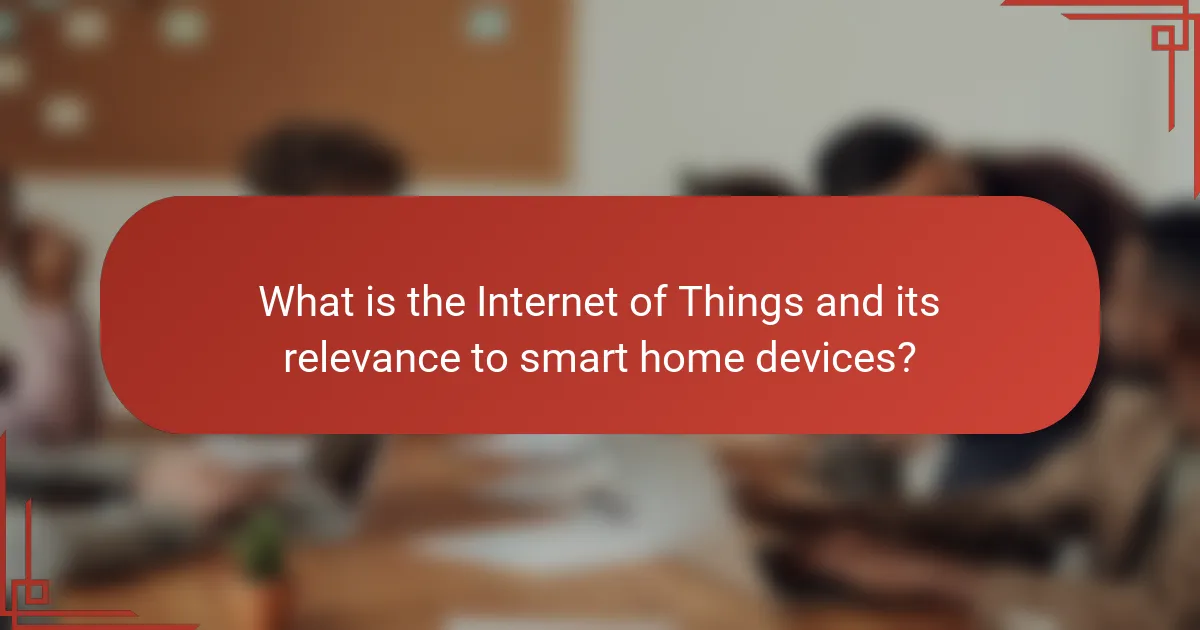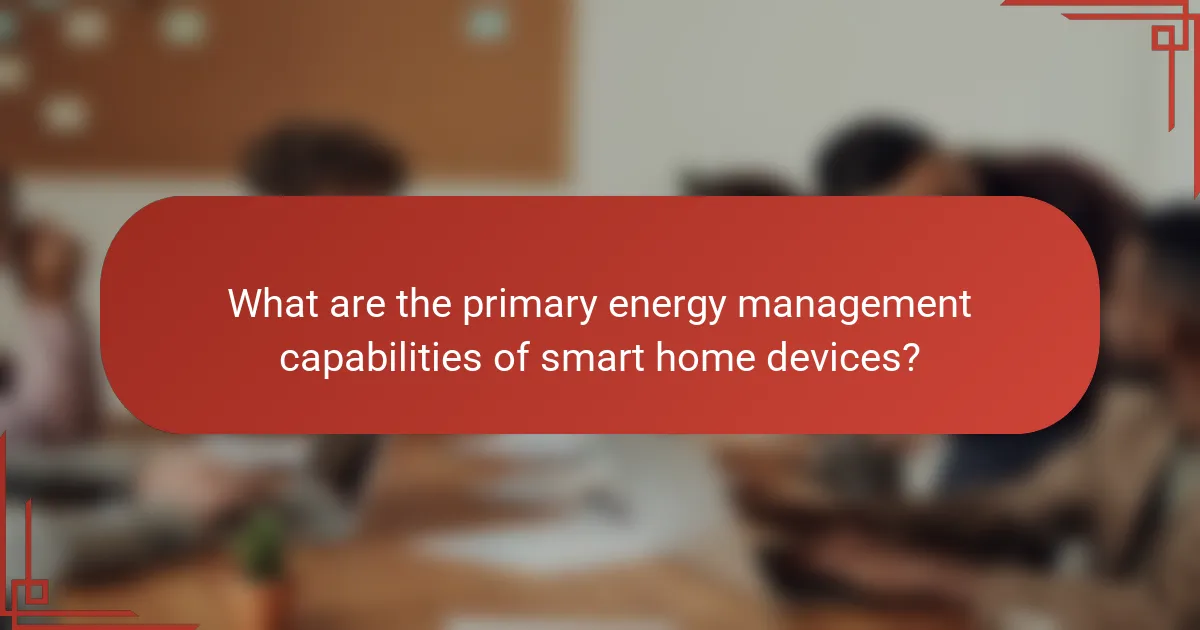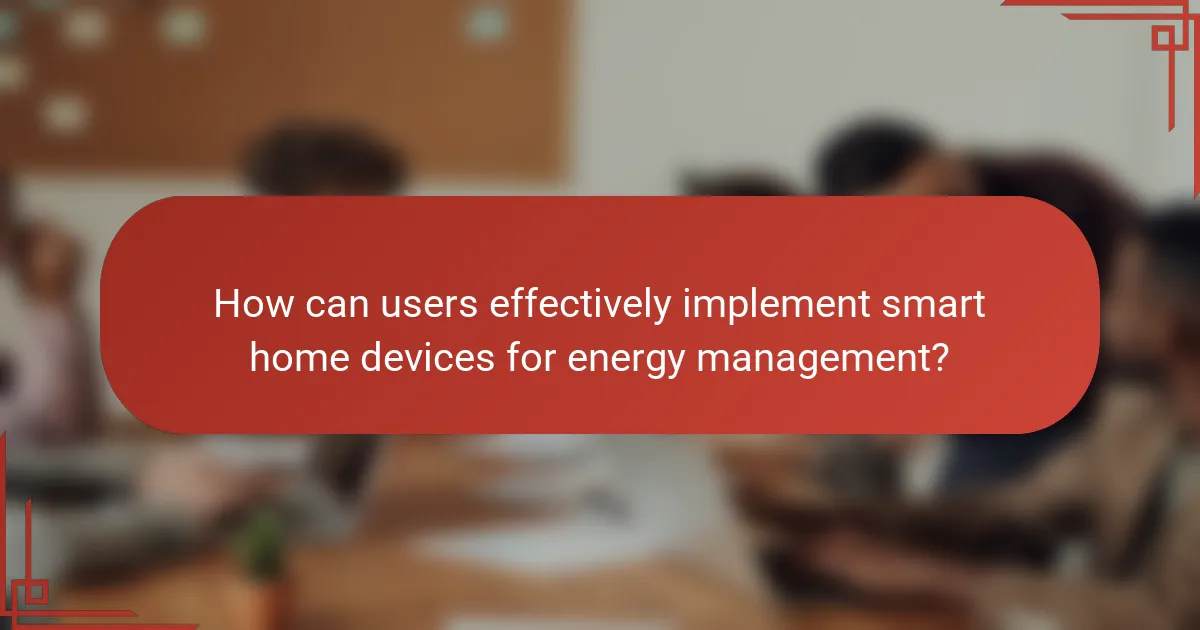The Internet of Things (IoT) encompasses a network of interconnected devices that communicate and exchange data, significantly impacting various sectors, including smart home automation. Smart home devices, such as thermostats, lights, and security systems, utilize IoT technology to enhance convenience, efficiency, and energy management. These devices automate and optimize energy consumption, leading to potential savings on utility bills. For instance, smart thermostats can learn user preferences and adjust settings accordingly, while energy monitoring systems provide real-time data to identify consumption patterns. The global smart home market is expected to reach $174 billion by 2025, indicating the growing importance of IoT in transforming energy management within households.

What is the Internet of Things and its relevance to smart home devices?
The Internet of Things (IoT) refers to a network of interconnected devices that communicate and exchange data. These devices can range from everyday household items to complex industrial tools. In the context of smart home devices, IoT enables seamless integration and automation of home functions. Smart home devices, such as thermostats, lights, and security systems, use IoT technology to enhance convenience and efficiency. For example, a smart thermostat can learn user preferences and optimize energy usage accordingly. According to a report by Statista, the global smart home market is projected to reach $174 billion by 2025, highlighting the significant impact of IoT on home automation.
How do smart home devices function within the Internet of Things ecosystem?
Smart home devices function as interconnected components within the Internet of Things (IoT) ecosystem. They communicate with each other and with a central hub using wireless protocols such as Wi-Fi, Zigbee, or Bluetooth. This connectivity allows for real-time data exchange and remote control via smartphones or voice assistants.
Smart home devices collect data on user behavior and environmental conditions. This data enables automation and optimization of energy usage. For instance, smart thermostats learn user preferences and adjust heating or cooling accordingly.
The integration of smart home devices enhances energy management and efficiency. According to a 2021 report by the International Energy Agency, smart home technologies can reduce energy consumption by up to 30%. This demonstrates their significant role in the IoT ecosystem and energy management capabilities.
What types of smart home devices are commonly used?
Common types of smart home devices include smart speakers, smart thermostats, smart lights, and smart security cameras. Smart speakers like Amazon Echo and Google Nest enable voice control for various functions. Smart thermostats, such as the Nest Learning Thermostat, optimize heating and cooling based on user habits. Smart lights, including Philips Hue, allow for remote control and scheduling of lighting. Smart security cameras, like Ring and Arlo, provide real-time monitoring and alerts. These devices enhance convenience and energy efficiency in homes.
How do these devices communicate with each other?
Smart home devices communicate with each other through various protocols and technologies. These include Wi-Fi, Bluetooth, Zigbee, and Z-Wave. Each protocol has its own strengths and weaknesses. Wi-Fi allows for high data transfer rates but consumes more power. Bluetooth is energy-efficient for short-range communication. Zigbee and Z-Wave are designed for low-power, low-data-rate applications. They create mesh networks, enabling devices to relay messages to one another. This enhances connectivity and range within a smart home. The integration of these technologies allows devices to work together seamlessly, improving energy management and user experience.
What are the key benefits of using smart home devices for energy management?
Smart home devices for energy management provide several key benefits. They enable real-time monitoring of energy consumption. This allows homeowners to identify energy usage patterns and inefficiencies. Smart devices can automate energy-saving actions, such as adjusting heating or cooling based on occupancy. According to a study by the American Council for an Energy-Efficient Economy, smart thermostats can reduce energy bills by up to 10-12%. Additionally, these devices can integrate with renewable energy sources, optimizing their use. They also offer remote control capabilities, allowing users to manage energy usage from anywhere. Overall, smart home devices enhance energy efficiency and reduce costs.
How do smart home devices contribute to energy savings?
Smart home devices contribute to energy savings by optimizing energy usage and increasing efficiency. These devices include smart thermostats, smart lighting, and energy monitoring systems. Smart thermostats adjust heating and cooling based on occupancy and preferences. Studies show they can reduce energy consumption by up to 10-15%. Smart lighting systems automatically turn off when rooms are unoccupied. This can lead to significant reductions in electricity use. Energy monitoring systems provide real-time data on energy consumption. This allows homeowners to identify and address energy waste. Overall, smart home devices create a more efficient energy management system.
What environmental impacts can be mitigated through energy management?
Energy management can mitigate several environmental impacts, primarily greenhouse gas emissions. By optimizing energy use, energy management reduces reliance on fossil fuels. This leads to lower carbon dioxide emissions, which contribute to climate change. Additionally, efficient energy management decreases energy waste, minimizing the need for energy production. According to the U.S. Environmental Protection Agency, energy efficiency improvements can reduce emissions by 30% by 2030. Furthermore, energy management can lessen air and water pollution associated with energy production. This results in healthier ecosystems and improved public health outcomes. Overall, effective energy management plays a crucial role in reducing the environmental footprint of energy consumption.

What are the primary energy management capabilities of smart home devices?
Smart home devices primarily manage energy through automation, monitoring, and optimization. Automation allows devices to adjust settings based on user preferences or schedules. For instance, smart thermostats can learn user habits and adjust heating or cooling accordingly. Monitoring capabilities provide real-time data on energy consumption. This data helps users identify patterns and areas for improvement. Optimization features can suggest or implement energy-saving measures automatically. For example, smart plugs can turn off devices during peak energy hours. These capabilities collectively lead to reduced energy bills and improved efficiency. Studies show that homes with smart devices can reduce energy consumption by up to 30%.
How do smart thermostats optimize energy use?
Smart thermostats optimize energy use by learning user preferences and adjusting temperature settings accordingly. They analyze data on occupancy patterns and external weather conditions. This allows them to minimize energy consumption while maintaining comfort. For instance, smart thermostats can lower heating or cooling when a home is unoccupied. Studies show that smart thermostats can reduce energy bills by up to 10-15%. They often include features like scheduling, remote access, and integration with other smart devices. These features contribute to more efficient energy management in homes.
What features enable smart thermostats to learn user behavior?
Smart thermostats learn user behavior through features like adaptive scheduling, occupancy detection, and machine learning algorithms. Adaptive scheduling allows the thermostat to adjust temperature settings based on user patterns over time. Occupancy detection uses sensors to identify when people are present in the home, influencing heating and cooling cycles. Machine learning algorithms analyze data from user interactions and environmental factors to optimize energy use. These features create a responsive system that improves comfort and efficiency. Studies show that homes with smart thermostats can reduce energy consumption by up to 15%.
How can users control smart thermostats remotely?
Users can control smart thermostats remotely through mobile applications or web interfaces. These interfaces connect to the thermostat via Wi-Fi or cellular networks. Users can adjust temperature settings, create schedules, and monitor energy usage from anywhere. Many smart thermostats also offer integration with virtual assistants like Amazon Alexa or Google Assistant. This allows for voice control and automation features. Remote access enables users to make adjustments while away from home, enhancing convenience and energy efficiency. Studies show that remote control features can lead to significant energy savings, as users can optimize heating and cooling based on real-time needs.
What role do smart lighting systems play in energy management?
Smart lighting systems significantly enhance energy management by optimizing energy usage. These systems utilize sensors and automation to adjust lighting based on occupancy and natural light levels. For instance, smart lights can dim or turn off when a room is unoccupied. This capability can lead to energy savings of up to 30% in residential settings. Additionally, smart lighting can be programmed to follow user schedules, ensuring lights are only on when needed. According to a study by the U.S. Department of Energy, smart lighting solutions contribute to reduced energy consumption and lower electricity bills. Overall, smart lighting systems play a crucial role in efficient energy management.
How can smart lighting be programmed for efficiency?
Smart lighting can be programmed for efficiency by utilizing automated schedules and sensors. Timers can turn lights on and off based on user routines. Motion sensors can detect occupancy and adjust lighting accordingly. Dimming features can reduce energy consumption when full brightness is unnecessary. Integration with smart home systems allows for centralized control and monitoring. Energy usage data can inform users about consumption patterns. Studies show that smart lighting can reduce energy use by up to 30%.
What are the benefits of using LED technology in smart lighting?
LED technology in smart lighting offers energy efficiency, long lifespan, and precise control. Energy-efficient LEDs consume up to 75% less energy than incandescent bulbs. This reduction in energy use translates to lower electricity bills. LEDs also last significantly longer, with lifespans of 15,000 to 50,000 hours compared to 1,000 hours for traditional bulbs. This longevity reduces the frequency of replacements, lowering maintenance costs. Additionally, smart LEDs can be controlled remotely, allowing for automation and customization of lighting schedules. This feature enhances convenience and can contribute to energy savings. Overall, LED technology in smart lighting promotes sustainability and cost-effectiveness.

How can users effectively implement smart home devices for energy management?
Users can effectively implement smart home devices for energy management by integrating smart thermostats, smart plugs, and energy monitoring systems. Smart thermostats automatically adjust heating and cooling based on user habits, which can reduce energy consumption by up to 15%. Smart plugs allow users to control and schedule devices remotely, minimizing energy waste from idle electronics. Energy monitoring systems provide real-time data on energy usage, helping users identify patterns and areas for improvement. By utilizing these devices, users can optimize their energy consumption and potentially save on utility bills. Studies show that households using smart energy management systems can reduce their energy costs by 10-30%.
What steps should be taken to set up a smart home energy management system?
To set up a smart home energy management system, follow these steps. First, assess your energy consumption. Identify the devices and appliances that use the most energy. Next, choose a compatible smart energy management hub. This hub will connect all your smart devices. Then, install smart plugs and smart thermostats. These devices allow for remote control and monitoring of energy use. After that, configure your energy management system through its app. Set schedules and preferences for optimal energy efficiency. Finally, monitor your energy usage regularly. This helps you make informed decisions about your energy consumption.
What considerations should be made when selecting devices?
When selecting devices for smart home energy management, consider compatibility with existing systems. Ensure the device can integrate seamlessly with your current smart home ecosystem. Evaluate the energy efficiency ratings of the devices. Higher ratings often translate to lower energy consumption and costs. Assess the device’s functionality and features. Look for options that provide real-time monitoring and control. Research the manufacturer’s reputation for reliability and customer service. A reputable brand often indicates better support and product longevity. Lastly, consider the device’s security features. Enhanced security protects your network and personal data from potential breaches.
How can users ensure compatibility among devices?
Users can ensure compatibility among devices by checking for interoperability standards. Many smart home devices adhere to common protocols like Zigbee, Z-Wave, or Wi-Fi. Users should verify that their devices support the same standards. This information is typically found in the product specifications. Additionally, using a central hub can facilitate communication between different devices. Hubs often support multiple protocols, enhancing compatibility. Regular firmware updates can also improve device interoperability. Users should consult manufacturer documentation for compatibility details.
What best practices can enhance the energy efficiency of smart home devices?
To enhance the energy efficiency of smart home devices, users should implement several best practices. Regularly updating device firmware can optimize performance and reduce energy consumption. Scheduling devices to operate during off-peak hours can lower energy costs. Utilizing energy monitoring features helps identify high-consumption devices. Setting devices to energy-saving modes reduces unnecessary power usage. Integrating smart devices with a home automation system maximizes efficiency through coordinated operation. Choosing Energy Star certified devices ensures better energy performance. Finally, conducting routine maintenance keeps devices running efficiently and prolongs their lifespan.
How can regular maintenance improve device performance?
Regular maintenance can significantly improve device performance by ensuring optimal functionality. It involves routine checks, software updates, and hardware cleaning. These actions prevent issues such as overheating, slow processing, and connectivity problems. For instance, cleaning dust from vents can enhance airflow, which helps in cooling the device. Software updates often include performance enhancements and security patches. According to a study by IBM, regular maintenance can increase device lifespan by up to 30%. This leads to better energy efficiency and reduced operational costs over time. Therefore, consistent maintenance is essential for maintaining high performance in smart home devices.
What common troubleshooting tips can help users maximize energy savings?
To maximize energy savings, users should regularly check their smart devices for updates. Keeping firmware up-to-date can improve efficiency. Users should also monitor energy consumption through device apps. This helps identify high-energy usage patterns. Setting timers and schedules for devices can reduce unnecessary energy use. Additionally, users should ensure that devices are placed correctly for optimal performance. For instance, thermostats should be away from heat sources. Regularly cleaning and maintaining devices can also enhance their efficiency. Lastly, users should disconnect devices that are not in use to prevent phantom energy loss.
The Internet of Things (IoT) is a network of interconnected devices that communicate and exchange data, significantly impacting smart home devices and their energy management capabilities. This article explores how smart home devices, such as thermostats, lights, and security systems, utilize IoT technology to enhance convenience and optimize energy consumption. Key topics include the functionality of smart home devices within the IoT ecosystem, types of devices commonly used, their communication protocols, and their role in energy savings and environmental impact. Additionally, the article outlines best practices for implementing and maintaining these devices to maximize energy efficiency.


